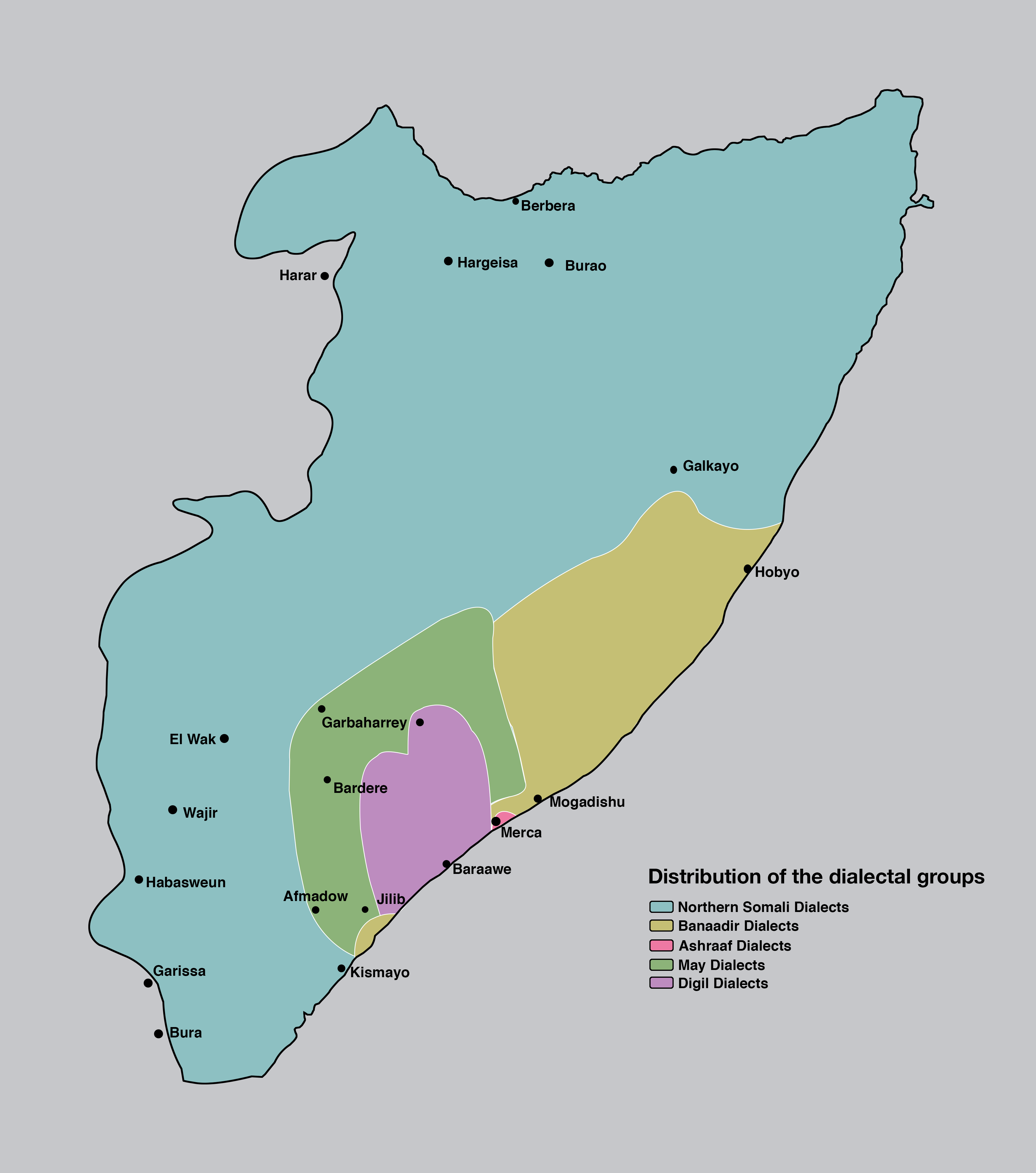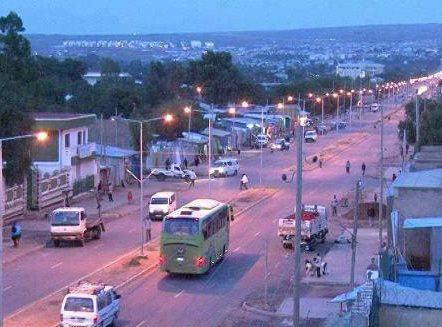|
Ajuran (clan)
The Ajuran ( Somali: Ajuuraan, Beesha Ajuuraan, Morshe, Arabic: أجران) is a Somali clan, part of the Jambelle clan which itself belongs to the largest Somali clan-family — the Hawiye. Ajuran members largely inhabit Kenya as well as southern east Ethiopia; considerable numbers are also found in southern Somalia. Some Ajuran members settled in Mogadishu. Overview The Ajuran clan's origins are found in the Ajuran Sultanate, a Somali Muslim sultanate that ruled over large parts of the Horn of Africa in the Middle Ages. Today they largely live in Kenya, the North Eastern Province and the Somali region of Ethiopia, but also in Somalia. The Ajuran primarily speak the Somali language. The Ajuran are said to be part of the Jambelle Hawiye but became displaced from modern Hawiye territories in the late 17th to early 18th centuries due to historical conflict particularly in South Central Somalia. Lee Cassanelli in his 1982 book "''The Shaping of Somali Society: Recon ... [...More Info...] [...Related Items...] OR: [Wikipedia] [Google] [Baidu] |
Somali Language
Somali (Latin script: ; Wadaad: ; Osmanya: 𐒖𐒍 𐒈𐒝𐒑𐒛𐒐𐒘 ) is an Afroasiatic language belonging to the Cushitic branch. It is spoken as a mother tongue by Somalis in Greater Somalia and the Somali diaspora. Somali is an official language in Somalia and Ethiopia, and a national language in Djibouti as well as in northeastern Kenya. The Somali language is written officially with the Latin alphabet although the Arabic alphabet and several Somali scripts like Osmanya, Kaddare and the Borama script are informally used.Lewis, I.M. (1958)The Gadabuursi Somali Script ''Bulletin of the School of Oriental and African Studies'', University of London, Vol. 21, pp. 134–156. Classification Somali is classified within the Cushitic branch of the Afroasiatic family, specifically, Lowland East Cushitic in addition to Afar and Saho. Somali is the best-documented of the Cushitic languages, with academic studies of the language dating back to the late 19th century. ... [...More Info...] [...Related Items...] OR: [Wikipedia] [Google] [Baidu] |
Sultanate
This article includes a list of successive Islamic state, Islamic states and History of Islam, Muslim dynasties beginning with the time of the Islamic prophet Muhammad (570–632 CE) and the early Muslim conquests that Spread of Islam, spread Islam outside of the Arabian Peninsula, and continuing through to the present day. The first-ever establishment of an Islamic polity goes back to the Muhammad in Medina, Islamic State of Medina, which was established by Muhammad in the city of Medina in 622 CE. Following Death of Muhammad, his death in 632 CE, Rashidun, his immediate successors established the Rashidun Caliphate, which was further succeeded by the Umayyad Caliphate and later the Abbasid Caliphate. While the primary Caliphate, caliphates gradually fractured and fell, other Muslim dynasties rose; some of these dynasties established notable and prominent Islamic empires, such as the Ottoman Empire centered around Anatolia, the Safavid Iran, Safavid Empire of Greater Iran, Persi ... [...More Info...] [...Related Items...] OR: [Wikipedia] [Google] [Baidu] |
Maay Maay
Mai-Mai, commonly spelled Maay Maay (also known as ''Af-Maay'', ''Af-Maymay'', or simply ''Maay''; the ''Mai-Mai'' spelling is rarely used but it is most often spoken), is a dialect of the Somali language of the Cushitic branch of the Afro-Asiatic family. It is mainly spoken in Somalia and adjacent parts of Ethiopia and Kenya. In Somalia, it is spoken in South West state, Jubaland state, and Banadir. It is one of the dialects of the Somali language. Overview Somali linguistic varieties are divided into three main groups: Northern, Benadir, and Maay. Northern Somali (or Northern-Central Somali) forms the basis for Standard Somali. Maay is principally spoken by the Digil and Mirifle ( Rahanweyn) clans in the southern regions of Somalia, particularly in South West. Its speech area extends from the southwestern border with Ethiopia to a region close to the coastal strip between Mogadishu and Kismayo, including the city of Baidoa. Maay is not mutually comprehensible with Norther ... [...More Info...] [...Related Items...] OR: [Wikipedia] [Google] [Baidu] |
Mogadishu Sultanate
The Sultanate of Mogadishu ( so, Saldanadda Muqdisho, ar, سلطنة مقديشو) (fl.9th- 13th centuries), also known as the Kingdom of Magadazo, was a medieval Somali sultanate centered in southern Somalia. It rose as one of the pre-eminent powers in the Horn of Africa under the rule of Fakhr al-Din before becoming part of the powerful and expanding Ajuran Empire in the 13th century. The Mogadishu Sultanate maintained a vast trading network, dominated the regional gold trade, minted its own currency, and left an extensive architectural legacy in present-day southern Somalia. Ethnicity The ethnic origins of the founders of Mogadishu and its subsequent sultanate has been the subject of much debate in Somali Studies. I.M Lewis postulates that the city was founded and ruled by a council of Arab and Persian families.I.M. Lewis, ''Peoples of the Horn of Africa: Somali, Afar, and Saho, Issue 1'', (International African Institute: 1955), p. 47.I.M. Lewis, ''The modern history of S ... [...More Info...] [...Related Items...] OR: [Wikipedia] [Google] [Baidu] |
Somali Calendar
The Somali calendar, ( so, Soomaali tiro ammin) which is a moon The Moon is Earth's only natural satellite. It is the fifth largest satellite in the Solar System and the largest and most massive relative to its parent planet, with a diameter about one-quarter that of Earth (comparable to the width ...-and- sun-based system, was used by herders and farmers to determine the seasons and predict the weather. The Somali lunar calendar is known as ''dayax-tiriska'' and the sun-based calendar is called ''amin-tiris'' or ''shin-tiris''. References * "Orthodox" Muslims in Somalia disapproved of the Dabshid feast (Barile, La colonizzazione fascista, p.128)at Google Books * Said M-Shidad Hussein, ''The Somali Calendar: An Ancient, Accurate Timekeeping System''Somali calendarat Wardheer.startlogic.com {{Somalia-stub Somali culture Specific calendars Time in Somalia ... [...More Info...] [...Related Items...] OR: [Wikipedia] [Google] [Baidu] |
Southern Arabia
South Arabia () is a historical region that consists of the southern region of the Arabian Peninsula in Western Asia, mainly centered in what is now the Republic of Yemen, yet it has also historically included Najran, Jizan, Al-Bahah, and 'Asir, which are presently in Saudi Arabia, and the Dhofar of present-day Oman. South Arabia is inhabited by people possessing distinctive linguistic and ethnic affinities, as well as traditions and culture, transcending recent political boundaries. There are two indigenous language groups: the now extinct Old South Arabian languages and the unrelated Modern South Arabian languages, both members of the Semitic family. Etymology The term ''Yamnat'' was mentioned in Old South Arabian inscriptions on the title of one of the kings of the second Himyarite Kingdom known as Shammar Yahrʽish II. The term was probably referring to the southwestern coastline of the Arabian peninsula and the southern coastline between Aden and Hadramout. On ... [...More Info...] [...Related Items...] OR: [Wikipedia] [Google] [Baidu] |
Somali Region
The Somali Region ( so, Deegaanka Soomaalida, am, ሱማሌ ክልል, Sumalē Kilil, ar, المنطقة الصومالية), also known as Soomaali Galbeed (''Western Somalia'') and officially the Somali Regional State, is a regional state in eastern Ethiopia. Its territory is the largest after Oromia Region. The regional state borders the Ethiopian regions of Afar and Oromia and the chartered city Dire Dawa (Dire Dhawa) to the west, as well as Djibouti to the north, Somaliland to the northeast, Somalia to the south; and Kenya to the southwest. Jijiga is the capital of the Somali Region. The capital was formerly Gode, until Jijiga became the capital in 1995 on account of political considerations. The Somali regional government is composed of the executive branch, led by the President; the legislative branch, which comprises the State Council; and the judicial branch, which is led by the State Supreme Court. Overview The Somali Region formed a large part of the pre- ... [...More Info...] [...Related Items...] OR: [Wikipedia] [Google] [Baidu] |
North Eastern Province (Kenya)
The North Eastern Province ( so, Gobolka Woqooyi Bari, 𐒌𐒙𐒁𐒙𐒐𐒏𐒖 𐒓𐒙𐒎𐒝𐒕𐒘 𐒁𐒖𐒇𐒘) is one of the former provinces in Kenya. It has a land area of 127,358.5 km2, with its capital at Garissa. Previously known as the Northern Frontier District (NFD), the North Eastern Province territory was carved out of the present-day southern Somalia during the colonial period. However, during negotiations for Kenya's independence, Britain granted administration of the NFD to Kenyan nationalists despite an informal plebiscite showing the overwhelming desire of the region's population to join the newly formed Somali Republic. It is, and has historically been, mostly inhabited by ethnic Somalis.Rhoda E. Howard, ''Human Rights in Commonwealth Africa'', (Rowman & Littlefield Publishers, Inc.: 1986), p.95 History The Northern Frontier District came into being in 1925, when it was carved out of the present-day southern Somalia. At the time under Brit ... [...More Info...] [...Related Items...] OR: [Wikipedia] [Google] [Baidu] |
Ufahamu
''Ufahamu: A Journal of African Studies'' is a graduate-student run, peer-reviewed academic journal published at the University of California, Los Angeles (UCLA). It was established by the UCLA African Activist Association in 1970 and named after the Swahili word for comprehension, understanding, or being. The journal is published three times a year and is available from the University of California's eScholarship website. It describes itself as the "oldest student-run journal of Africanist scholarship." ''Ufahamu'' is published in English, with occasional poetry or articles in African and European languages. It is indexed in the MLA International Bibliography, Africa-Wide Information, and Historical Abstracts. Origin and purpose ''Ufahamu'' was conceived in 1969 by a group of graduate students active in UCLA's African Activist Association and African Studies Center, after a black-white confrontation at the 1969 African Studies Association in Montreal, where the black caucus crit ... [...More Info...] [...Related Items...] OR: [Wikipedia] [Google] [Baidu] |
Medieval
In the history of Europe, the Middle Ages or medieval period lasted approximately from the late 5th to the late 15th centuries, similar to the post-classical period of global history. It began with the fall of the Western Roman Empire and transitioned into the Renaissance and the Age of Discovery. The Middle Ages is the middle period of the three traditional divisions of Western history: classical antiquity, the medieval period, and the modern period. The medieval period is itself subdivided into the Early, High, and Late Middle Ages. Population decline, counterurbanisation, the collapse of centralized authority, invasions, and mass migrations of tribes, which had begun in late antiquity, continued into the Early Middle Ages. The large-scale movements of the Migration Period, including various Germanic peoples, formed new kingdoms in what remained of the Western Roman Empire. In the 7th century, North Africa and the Middle East—most recently part of the Eastern Roman ... [...More Info...] [...Related Items...] OR: [Wikipedia] [Google] [Baidu] |
Horn Of Africa
The Horn of Africa (HoA), also known as the Somali Peninsula, is a large peninsula and geopolitical region in East Africa.Robert Stock, ''Africa South of the Sahara, Second Edition: A Geographical Interpretation'', (The Guilford Press; 2004), p. 26 Located on the easternmost part of the African mainland, it is the fourth largest peninsula in the world. It is composed of Ethiopia, Eritrea, Somalia and Djibouti; broader definitions also include parts or all of Kenya, Sudan, South Sudan, and Uganda. The term Greater Horn Region (GHR) can additionally include Burundi, Rwanda, and Tanzania. It lies along the southern boundary of the Red Sea and extends hundreds of kilometres into the Guardafui Channel, Gulf of Aden, and Indian Ocean and shares a maritime border with the Arabian Peninsula of Western Asia. Names This peninsula has been known by various names. Ancient Greeks and Romans referred to it as Regio Aromatica or Regio Cinnamonifora due to the aromatic plants or as Regio ... [...More Info...] [...Related Items...] OR: [Wikipedia] [Google] [Baidu] |





